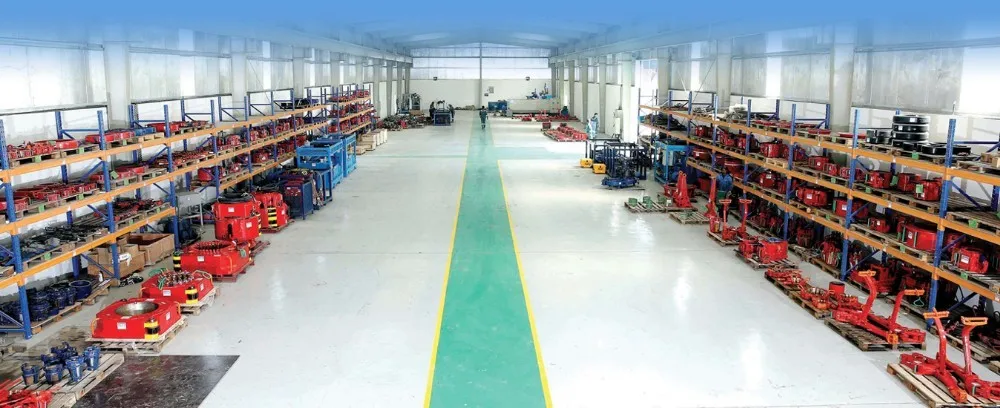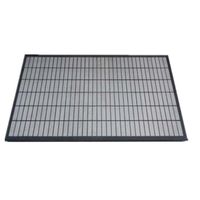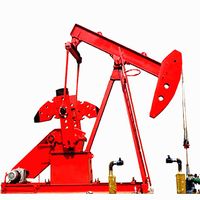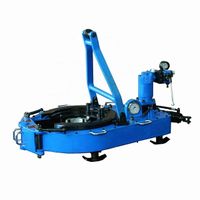API 7K Model KHT8625 hydraulic casing power tong/hydraulic power tong for the catching size from 2 3/8" to 8 5/8"
-
Supplier: Dongying Qixiang Import & Export Co., Ltd. -
Region: Shandong, China -
Contact: Ms Eve Liu -
Price: $29358.00 /set -
Min. Order: 1 set
| Selling Units: | Single item; | Packaging Detail: | Standard export package or as your request; |
| Brand Name: | DYQX; | Processing Type: | Forging; |
| Package Preview: | ; | Machine Type: | Drilling Tool; |
| Material: | Carbon Steel; | Single package size: | 130X95X95 cm; |
| Place of Origin: | China (Mainland); | Applicable Industries: | Energy & Mining; |
| Single gross weight: | 1500.0 KG; | Type: | Power Tong,Drill pipe; |
| Use: | Well Drilling; | Model Number: | KHT13625,DYQX; |
| Certification: | API; |
KHT8625 hydraulic casing power tong
1. INTRODUCTION
1. INTRODUCTION
KHT8625 Casing Power Tong is used to make up and break out for casing operation in oil fields. It has greatly reduced the labor of worker, enhanced connection quality of thread and diminished accidents in inappropriate casing operation. The power tong has the following features as well:
Opening type, convenient and prompt to enter and slide off the working position, with an integral tong head of great strength and rigidity.
Double swing head jaws, convenient to assemble and disassemble.
Brake belt assembly, easy to operate and convenient to maintain and replace.
Open gear supporting structure, improving the strength and rigidity.
Wholly hydraulic mode and mechanical gear shift.
High strength steel plate used on the shell,increasing the strength. The jaws are cast with precise technology, artistic and strong.
With hydraulic torque indicator and also installation interface, convenient to realize the computer management.
Use safety door hydraulic safety device,of great safety performance.
Large torque range,can meet the requirement of larger torque use.
2. SPECIFICATIONS
2.1. Jaws available for casing sizes 2 3/8″-8 5/8″
Three kinds of common jaws that we supply: 5 1/2″ ,6 5/8″ ,8 5/8″; Others:2 3/8″,2 7/8″,3 1/2″,4″,4 1/2″,5″,7″,7 5/8″,8 5/8″jaws can be equipped according to customer's needs
2.2. Opening size 9″/ 228.5mm
2.3. Tong head rotation speed
High gear: 48 rpm Low gear: 10 rpm
2.4. Rated torque High gear: 5200 ft.lbs/7 kN.m Low gear: 25000 ft.lbs/34 kN.m
2.5. Rated pressure 2000 PSI/14 MPa
2.6. Work flow 50 GPM/189 L/min
2.7. Overall dimension(L×W×H) 55.1″×37.5″×70.8″ / 1400×955×1800 mm
2.8. Weight 1200 kg/2640 lb
3. OPERATION
To insure reliable operation of the tong, it is essential that it is suspended properly. Hydraulic hoses must be hooked up correctly, and the following instructions concerning tong start up must be followed:
Jaw installation (see illustration below):

To install the jaws, remove the two jaw pivot bolts from the cage plate. Plate one jaw at a time between the upper and lower cage plates with the jaw roller pin facing upward. Align the hole in the jaw with the matching hole in the cage plates, and insert the jaw pivot bolt.
3.2.Tong rig-up
3.2.1. Hang line
The tong should be suspended by 5/8" diameter wire rope, and from a location in the derrick high enough to assure easy handling and maneuvering of the tong. One end of the rope should be placed through the pulley. The other end should be tied off in the derrick to form a dead line through a reaction of about 13kN-18kN to keep balance of the tong. If it can’t be tied off in the derrick, it is necessary to use a double spring hanger assembly. This spring hanger allows the tong to compensate for the downward movement of the casing as the thread made-up.
3.2.2. Hydraulic hoses
When the power unit is not running, or the hydraulic pump is disengaged, the hydraulic hoses may be installed to the tong. The possibility of error in interchanging the high pressure supply hose and the return hose has been eliminated by using a 1" high pressure hose and a 1-1/4" return hose. These hose couplings are the self-seal type, and care should be taken to insure complete engagement to prevent partial closure of the check valve in the coupling.

3.2.3. Back-up line
The use of a 5/8" or larger wire rope is recommended for the tong back-up line. It should be securely connected to the load cell at the rear of the tong and tied off to a suitable anchor. To assure accurate operation of the load cell and torque gauge, the back-up line should be connected at a 90 degree angle with the tong, and in the same horizontal plane. (square and level) (see illustration below):

3.3 Tong operation
3.3.1 Start up procedure
Note: be sure the doors are closed and securely latched before power unit is started to insure safety for operation personnel.
Use start up procedures as recommended by the power unit engine operator’s manual. Prior to starting engine, an inspection should be made to assure proper lube oil level in the engine and hydraulic oil level in the hydraulic reservoir. Open the by-pass valve on the hydraulic system. Check all pressure and return line hose connections to make sure they are securely installed.
Note: Failure to have these hose connections tight will stop or restrict oil flow and the following failures
could occur:
a. If the pressure supply hose restricts or stops flow, it will result in high pressure on the power unit hydraulic system which will activate the hydraulic governor and speed the engine up to maximum RPM.
b. If the return line flow is stopped or restricted, it will result in high pressure on the power unit hydraulic
system, causing the engine to speed up to maximum RPM and possible failure of the motor seal.
After the hoses are checked, start the engine and allow it to idle until warm. After the power unit engine has been started and hydraulic oil has circulated for approximately 10 minutes, slowly close the by-pass valve which will allow oil to circulate through the hoses and to the tong. (circulating pressure should not exceed 200 PSI.) Place the tong gear shifter in low gear and rotate the tong slowly forward and then reverse with the throttle valve control lever. Once this has been done and the proper size jaws have been installed, the tong is then ready to run pipe.
3.3.2. Direction and speed control
The 4-way valve assembly controls direction, speed of rotation, and torque output. For clockwise rotation, push the valve handle forward, and for reverse rotation, pull the valve handle in the opposite direction. Speed in either direction is proportional to the distance that the valve handle is moved from the center or neutral position (see illustration):


3.3.4. Make up of casing
For proper make-up of a casing joint, the following procedure may be used:
a. Place tong around casing.
b. Close and latch door completely.
C. Place the backing pin in the hole for make-up.

a. Shift transmission into high gear.
b. Push the throttle valve handle forward slightly until casing threads begin to make-up.
c. When casing threads begin to make-up, push the valve handle to full forward until the tong begins to stall.
d. Release the throttle.
e. Shift gear box into low gear.
f. Engage throttle and make-up casing to desired torque.
g. Reverse tong to disengage jaws and rotate until the table gear aligns with the door opening.
h. Unlatch the door and remove the tong from pipe.
3.3.5. Break-out of Casing
For proper break-out of a casing joint, the following procedure may be used: a. Place tong around casing.
b. Close and latch door completely.
b. Place the backing pin in the hole (see illustration below) for break-out


shipping term: 30 days


4. Our service


-
api drill pipe lifts 7k oil rig lifts

-
API 7K Q3-3/8~12-3/4-75 Type B Manual Pliers

-
Oil pipe power tong API 7K TEDA hydraulic power tong

-
API 7K KHT13625 Teda Hydraulic Casing Power Tong for oil casing grabbing sizes from 2 3/8" to 13 5/8"

-
Elevator type BD

-
API DDZ Drill Pipe Lift

-
API Spec 8A/8C Skid Series Oil Well Drilling Elevator

-
API 8A/8C DDZ Oil Well Drill Pipe Elevator

-
API ZQ127 TEDA hydraulic drill pipe power tongs for TEDA wellhead

-
API 8A SLX lift for drilling

Other Products
-
 $200.00 / piece
$200.00 / piece -
 $2000.00 / set
$2000.00 / set -
 $20000.00 / set
$20000.00 / set -
 $34000.00 / set
$34000.00 / set -
 $1500.00 / set
$1500.00 / set -
 $14000.00 / set
$14000.00 / set -
 $1000.00 / set
$1000.00 / set -
 $7500.00 / set
$7500.00 / set -
 $150.00 / set
$150.00 / set -
 $14000.00 / set
$14000.00 / set


















